by Alberto J. Muniagurria and Eduardo Baravalle
The face is the mirror of the mind and therefore can show joy or sadness, pain, anxiety, depression and fear. In turn, the face also manifests general diseases, or pigmentation changes or metabolic alterations. It is in the observation of the face that the pale, ruddy, cyanotic, erythrocyanotic, or jaundice patient is first detected. The expression, coloration and shape of the facies should be observed. The most characteristic facies are described in the following paragraphs.
Facies corresponding to endocrine diseases
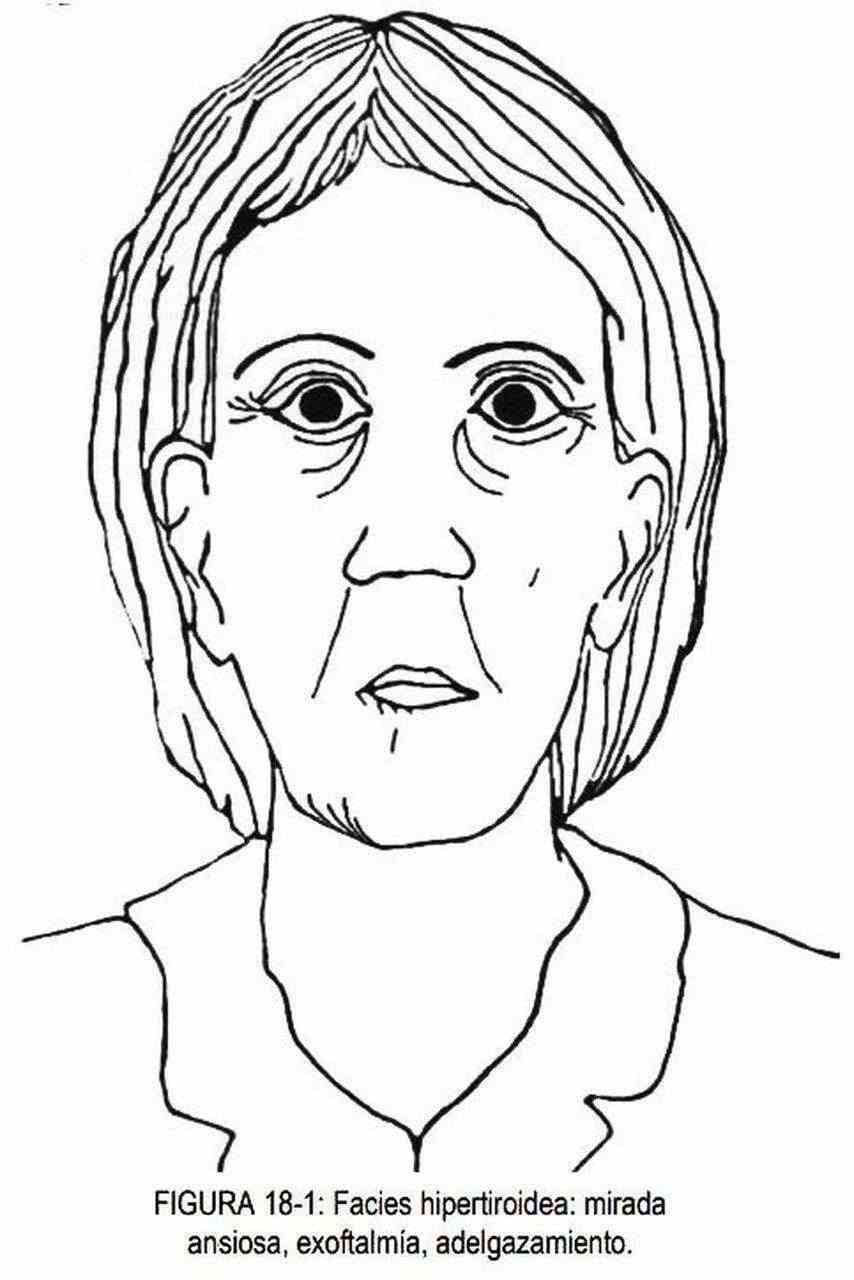 Hyperthyroid (Figure 18-1). The first sign that draws attention is the anxious look (scared face), which can be accompanied by exophthalmos and palpebral retraction; the skin is velvety and moist, the hair is fine, and the neck may be enlarged. Exophthalmos can be unilateral or bilateral, and is seen more frequently in Graves-Basedow disease.
Hyperthyroid (Figure 18-1). The first sign that draws attention is the anxious look (scared face), which can be accompanied by exophthalmos and palpebral retraction; the skin is velvety and moist, the hair is fine, and the neck may be enlarged. Exophthalmos can be unilateral or bilateral, and is seen more frequently in Graves-Basedow disease.
When these patients look downward, the upper eyelid reveals the sclera, because the eyelid does not accompany eye movements (a sign of eyelid retraction).
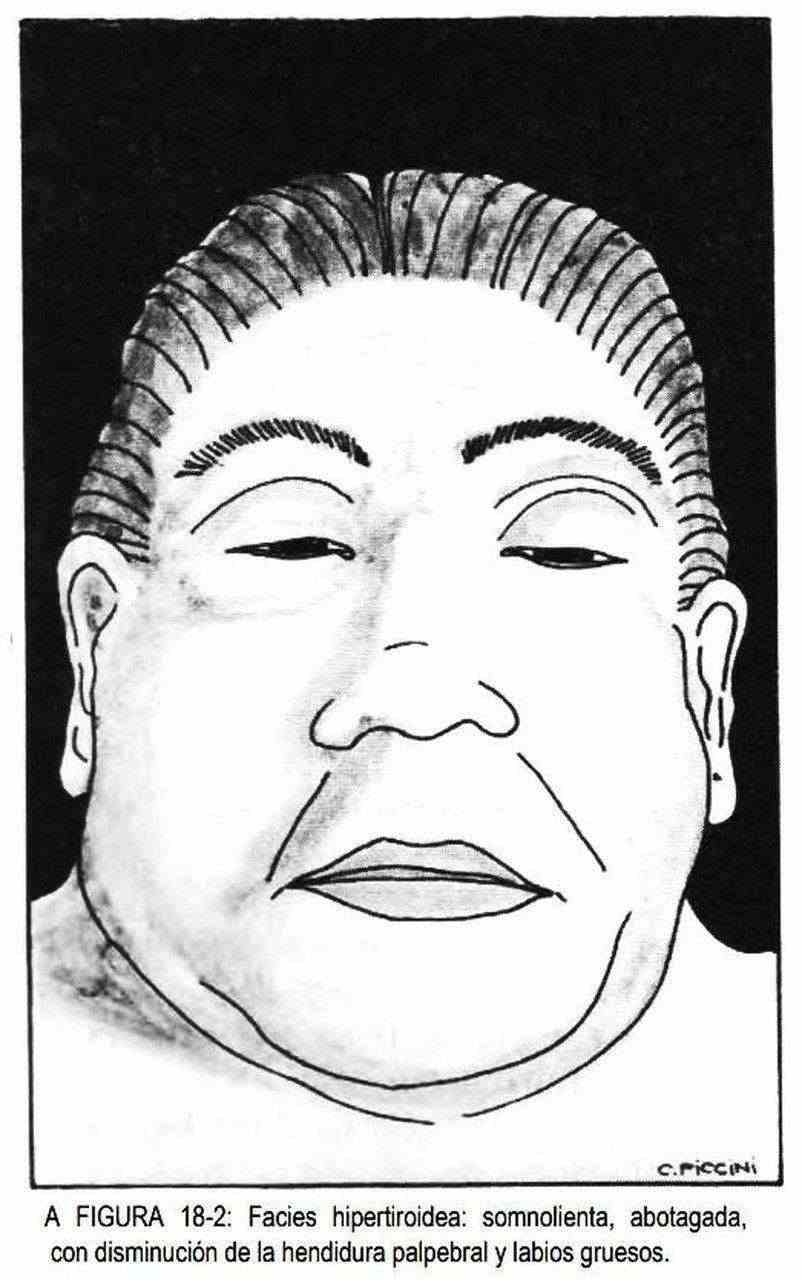 Hypothyroid . Edematous or bloated, it is primarily drowsy (Figure 18-2).
Hypothyroid . Edematous or bloated, it is primarily drowsy (Figure 18-2).
There is lingual enlargement, thick lips, and pale skin from anemia, dry and cold. The palpebral fissure is narrowed and the hair is sparse, with loss of the tail of the eyebrows. The sleepy appearance differs from the chronic kidney facies.
In cretin facies due to congenital hypothyroidism (Figure 18-3), mental weakness, protruding tongue, and salivary discharge are added. The cry resembles an almost inaudible moan.
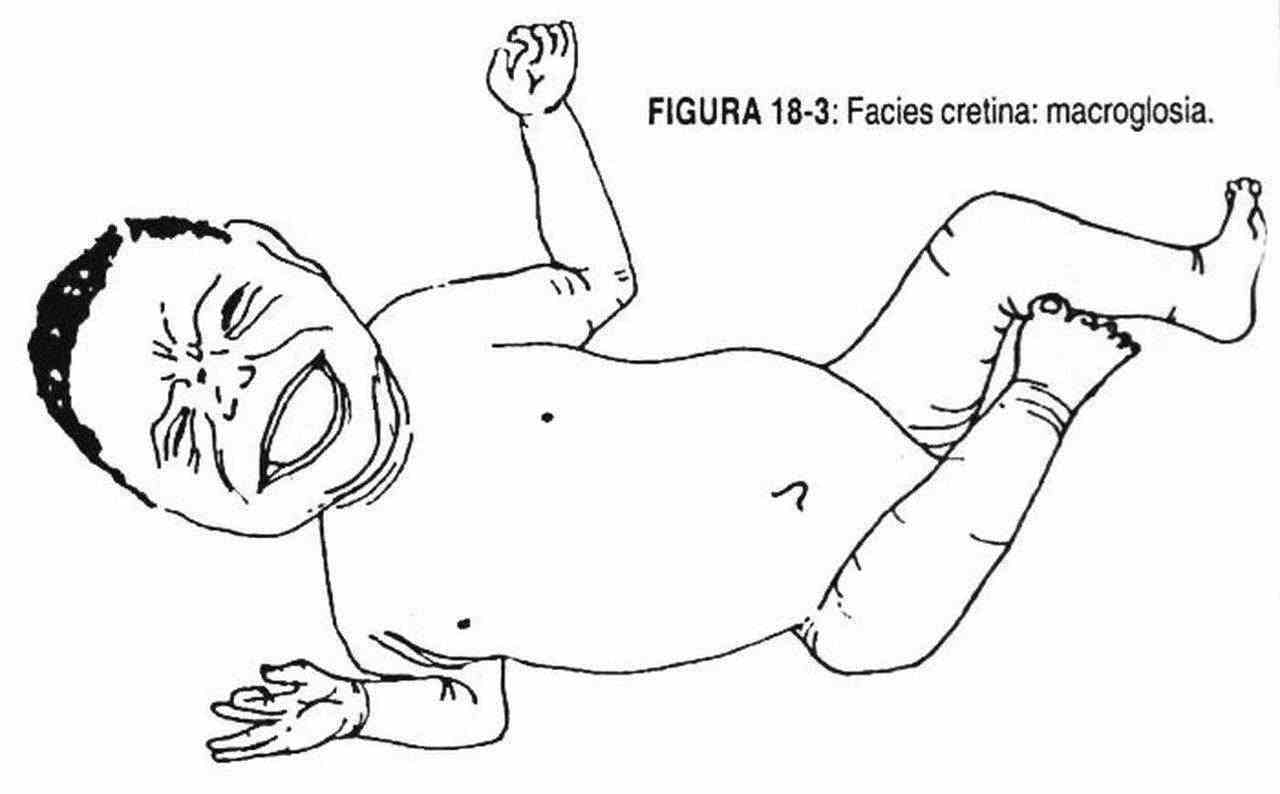
Acromegalic . This facies is characterized by the enlargement of the cartilage of the nose, prognathism of the lower jaw, which is due to the growth of the jaw, with separated teeth and enlargement of the paranasal sinuses. The tongue is large, and the superciliary and zygomatic arches are prominent. It is the Frankenstein facies (Figure 18-4). It is found in patients with pituitary tumors of somatotrophin-producing cells.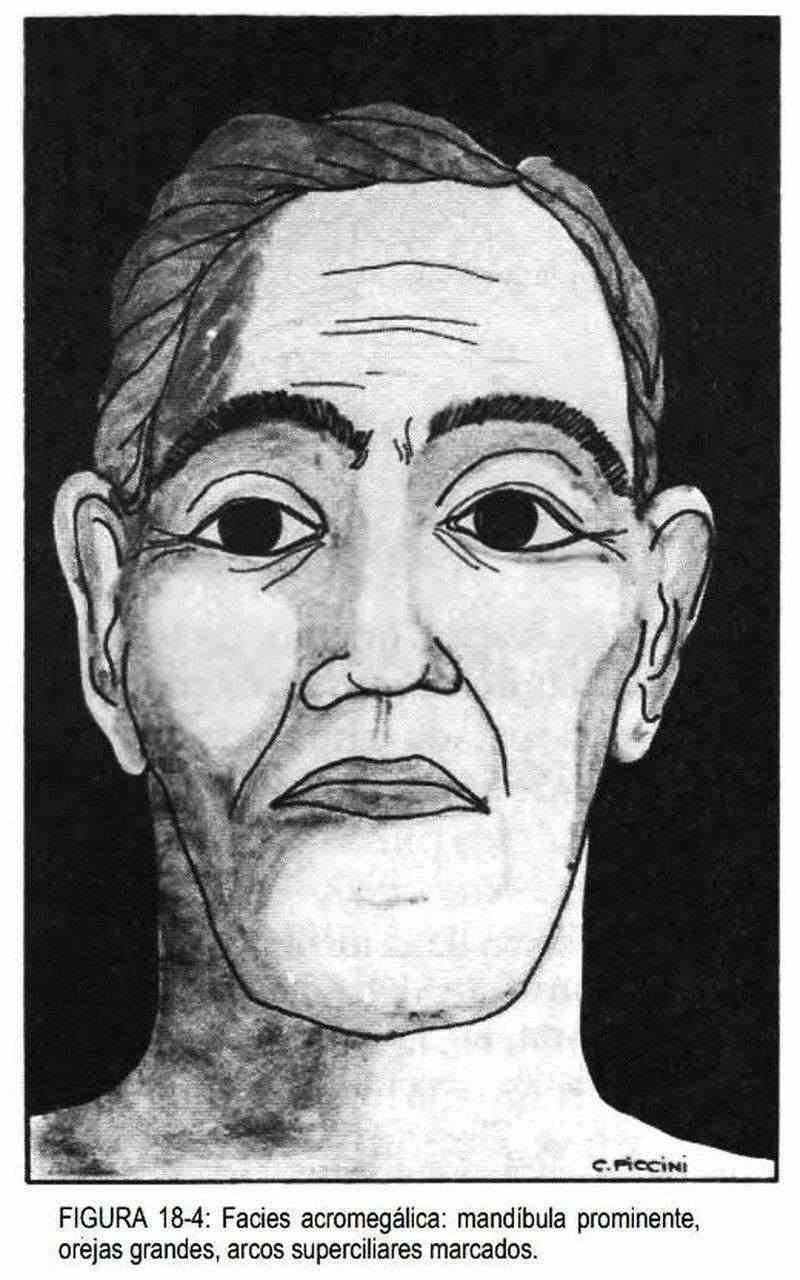
From Addison's disease . It is an expressionless face, in which the darkening of the skin and the presence of gray or brown pigmentation in the mouth or on the gums are striking.
Cushing's syndrome (Figures 18-5 and 18-6). It is round, ruddy, with bruises and ecchymoses.
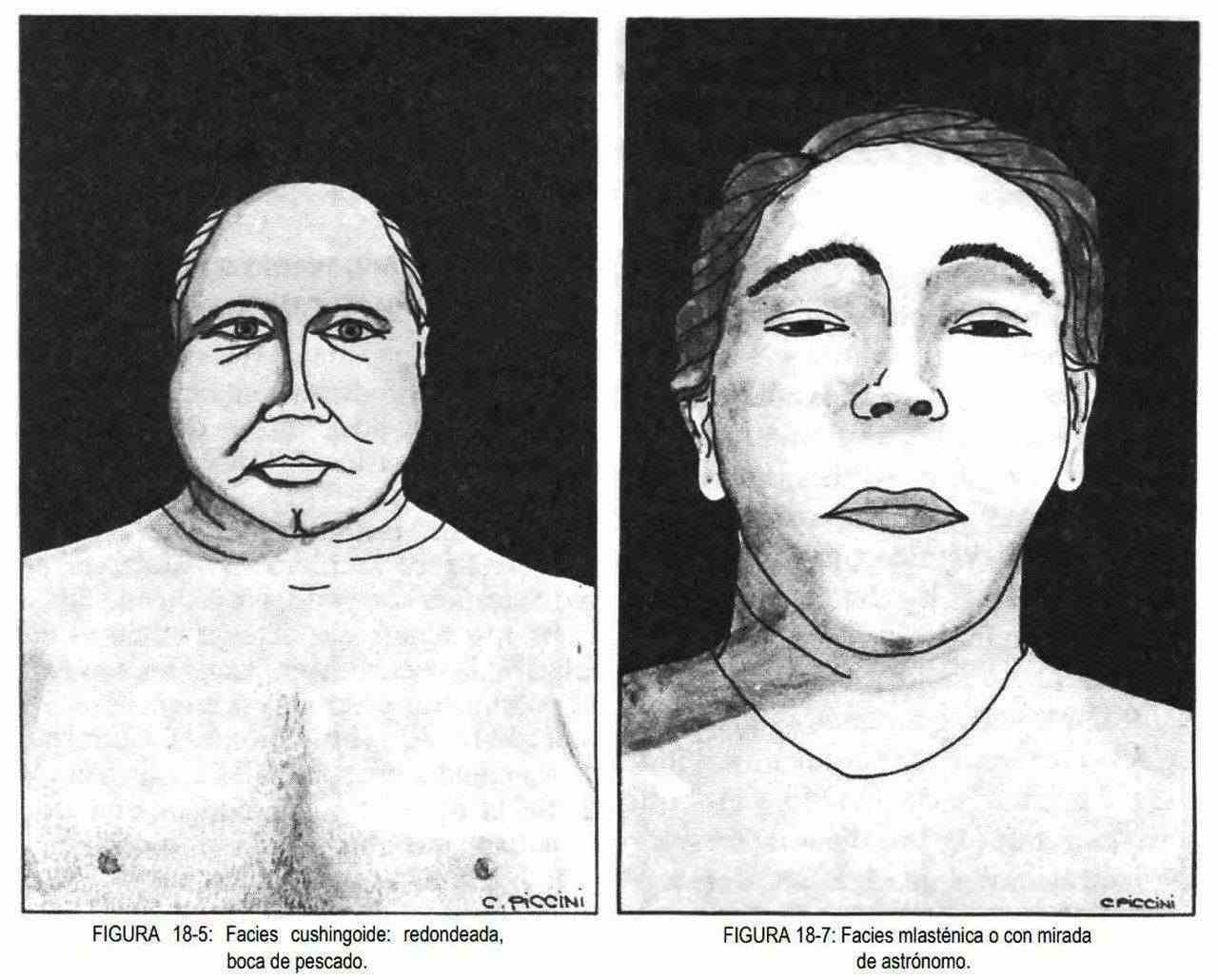
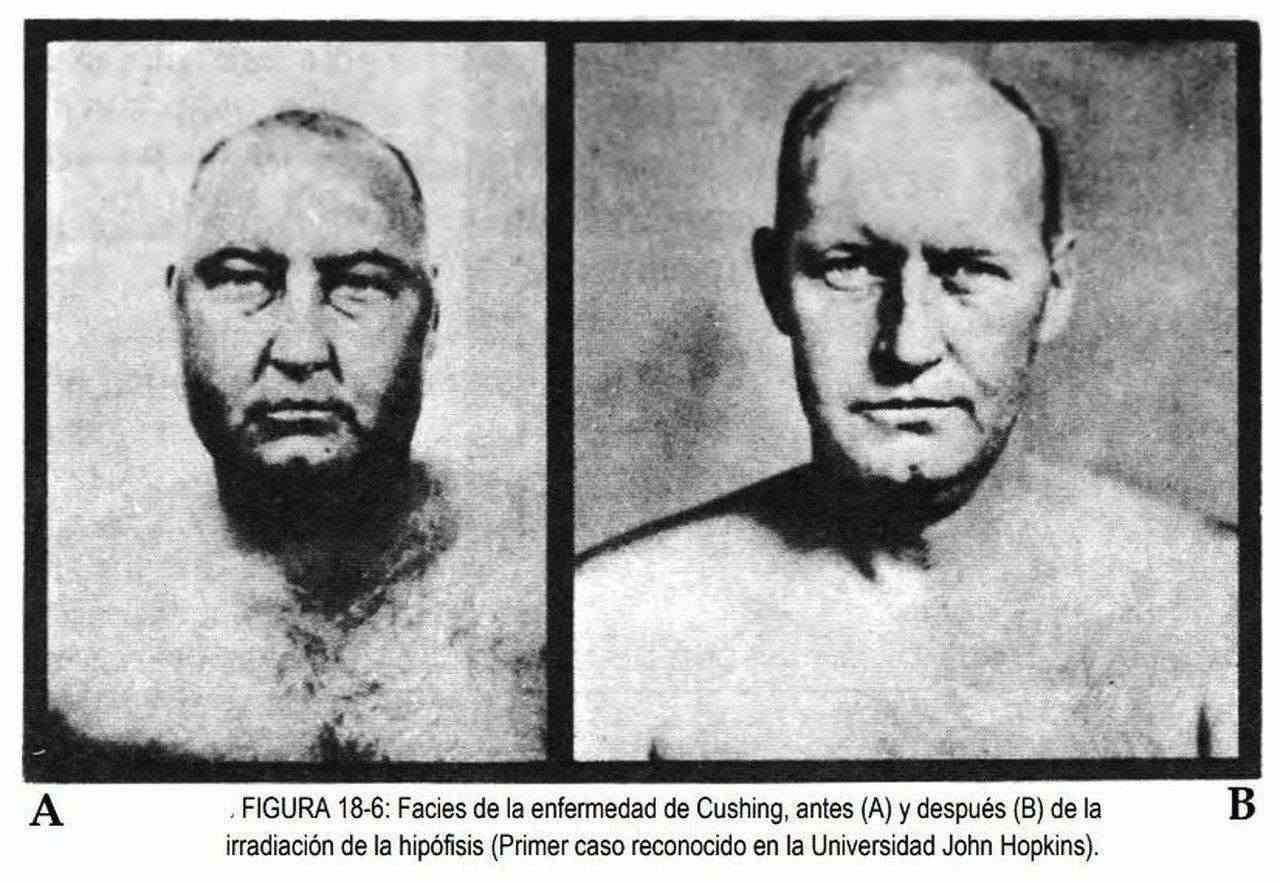 The adipose tissue is deposited in the cervical and dorsal area. Obesity is central, with thin limbs. The mediastinum may be widened due to increased adipose tissue, and hirsutism is common.
The adipose tissue is deposited in the cervical and dorsal area. Obesity is central, with thin limbs. The mediastinum may be widened due to increased adipose tissue, and hirsutism is common.
Achondroplastic . It is characterized by having a broad forehead with a flattened nose, and is observed in dwarfs with large heads.
Of virilization . They are hirsute women, with facial acne and baldness; they have a masculine appearance.
Facies corresponding to neurological diseases
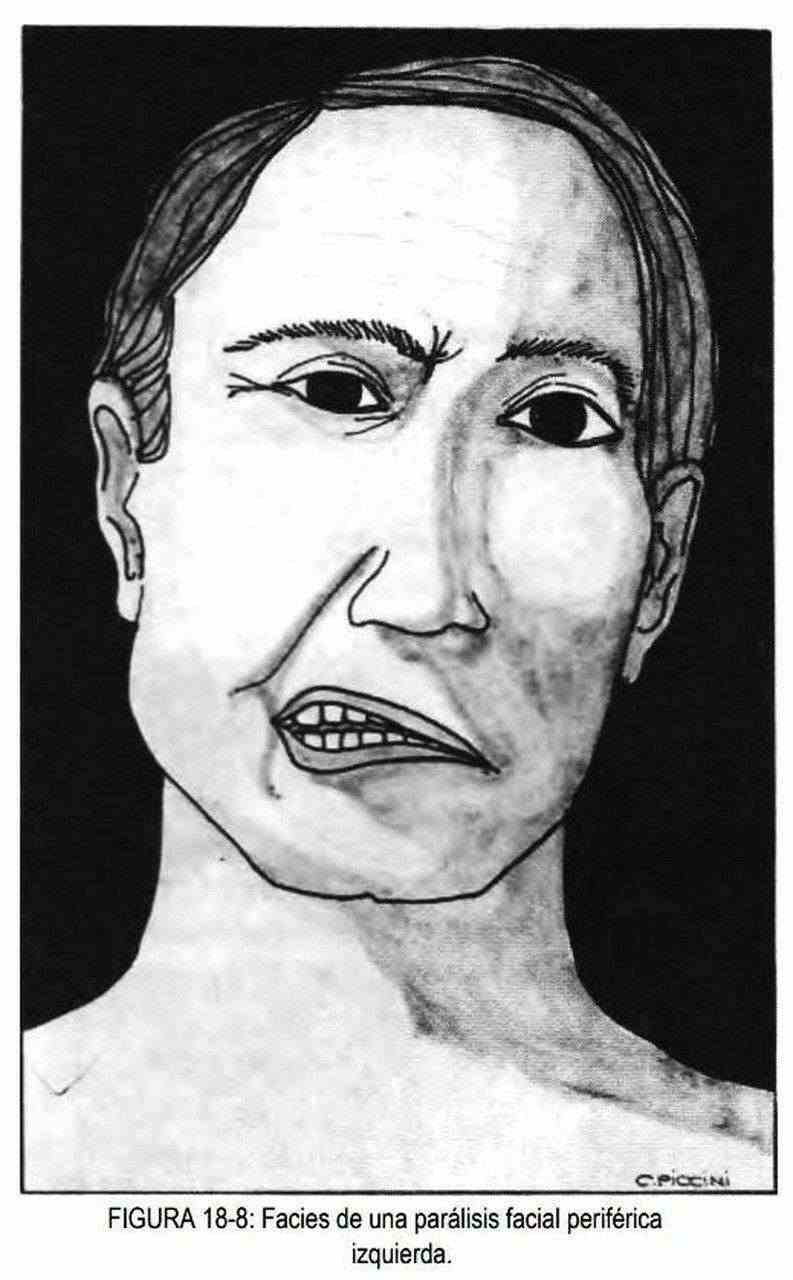 From Hutchinson . In this face the patient has drooping eyelids and in order to direct his gaze he tilts his head towards the side he wishes to look at; it is due to paralysis of all eye muscles.
From Hutchinson . In this face the patient has drooping eyelids and in order to direct his gaze he tilts his head towards the side he wishes to look at; it is due to paralysis of all eye muscles.
Mysthenic . It is a facies similar to the previous one, in which there is bilateral palpebral ptosis or drooping and muscular immobility; In order to direct the gaze, the patient leans back. It is also known as an astronomer's gaze facies (Figure 18-7). These patients, unlike the previous ones, feel better during the morning due to night rest, due to the accumulation of acetylcholine in the neuromuscular plaques.
Pseudobulbar . It is characterized by expressionlessness, alternating with episodes of unjustified laughter or crying.
From facial paralysis . When facial paralysis is peripheral, the individual presents, on the affected side, eyelid ptosis, epiphora, and deviation of the labial commissure towards the healthy side (Figure 18-8). The face of the affected side appears smoother and without relief than that of the healthy side. When trying to close the eye, it cannot do so, and the eyeball rises and reveals the sclera (Bell's sign); in turn, when trying to look up, the diseased eye excursions more than the healthy one (Nigro's sign).
From cerebral hemorrhage or vultuous facies . This facies is characterized by the immobility of the head, turned to one side, and the bulging of the cheek on the paralyzed side with each respiratory movement (sign of the pipe smoker).
Hydrocephalic . In this facies, the head is large and the forehead is bulging.
Of Sturge-Weber disease . It is characterized by the presence of a port wine-colored dermal angioma on the cheek, with different colored irises. There is a predominantly occipital cerebral angiomatosis, and a head murmur can be heard.
Facies corresponding to respiratory diseases
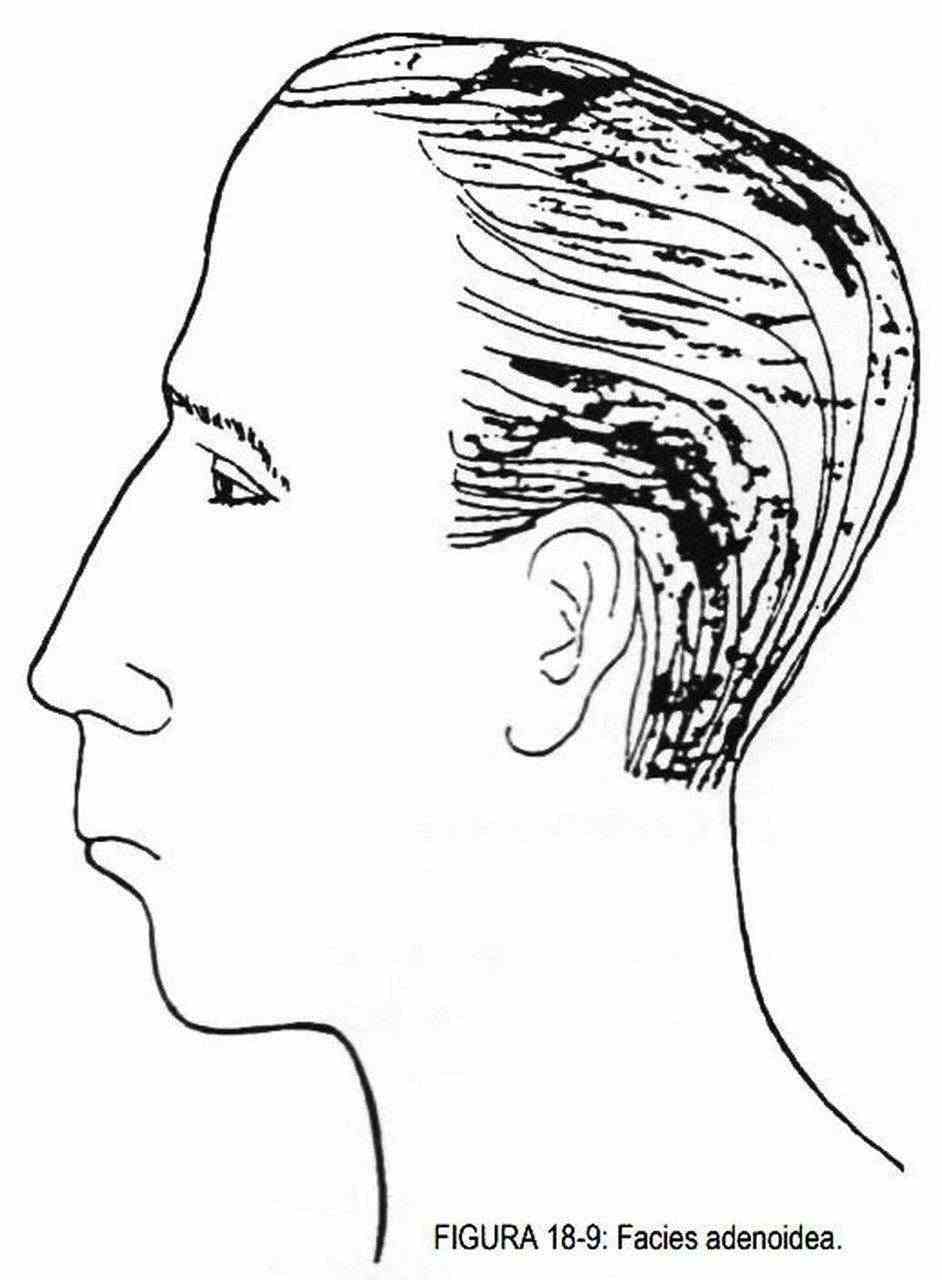 Pneumonic . In some patients with pneumonia, a vasodilation is observed at the level of the cheek on the side of the pulmonary disease, due to a reflex action of the sympathetic (pneumonic slap sign).
Pneumonic . In some patients with pneumonia, a vasodilation is observed at the level of the cheek on the side of the pulmonary disease, due to a reflex action of the sympathetic (pneumonic slap sign).
From the pink puffer . The patient shows a pale colored facies, with a pink tint, and breathes blowing, producing a resistance with the lips that tries to avoid alveolar collapse. It is found in patients with chronic obstructive pulmonary diseases.
Blue bloater . It corresponds to cyanotic patients, with puffy facies and nasal flaring. It is seen in individuals with chronic obstructive pulmonary diseases.
Adenoid . This facies presents a narrow nose, with mouth breathing, prognathism of the upper jaw, a raised palatal arch, and a small lower jaw (Figure 18-9).
Facies corresponding to infectious diseases
Congenital rubella . There are microcephaly, bilateral cataracts and alterations of the cartilage of the ears; there is also hearing loss and various cardiac malformations.
Chagas disease . In the acute phase, it is characterized by unilateral inflammatory edema at the oculopalpebral level (Romaña's sign) due to scratching caused by the itching produced by kissing bug droppings. It can be accompanied by satellite adenopathy.
Congenital syphilitic . Hutchinson's teeth, saddle nose and olympic forehead are observed; in this last zone there are bumps known as Parrot knots.
Of the mumps or urlean fever . It is characterized by unilateral or bilateral hypertrophy of the parotid glands. It should be noted, however, that not all parotid hypertrophy is infectious in origin.
Sardonic or cynical spasm . In this case there are wrinkles on the forehead and the outer corner of the eyes, and the eyebrows and wings of the nose are raised. The labial commissures are displaced outward and upward and the mouth is slightly open, contrasting the expression of pain on the upper side with that of laughter on the lower side. We observe it in tetanus, strychnine intoxication, and tonic facial spasm.
Facies corresponding to heart disease
From aortic insufficiency . Presents synchronous forward and backward movements or "yes-yes" sign, characteristic of the insufficiency of this valve (Musset's sign).
Facies corresponding to collagen diseases
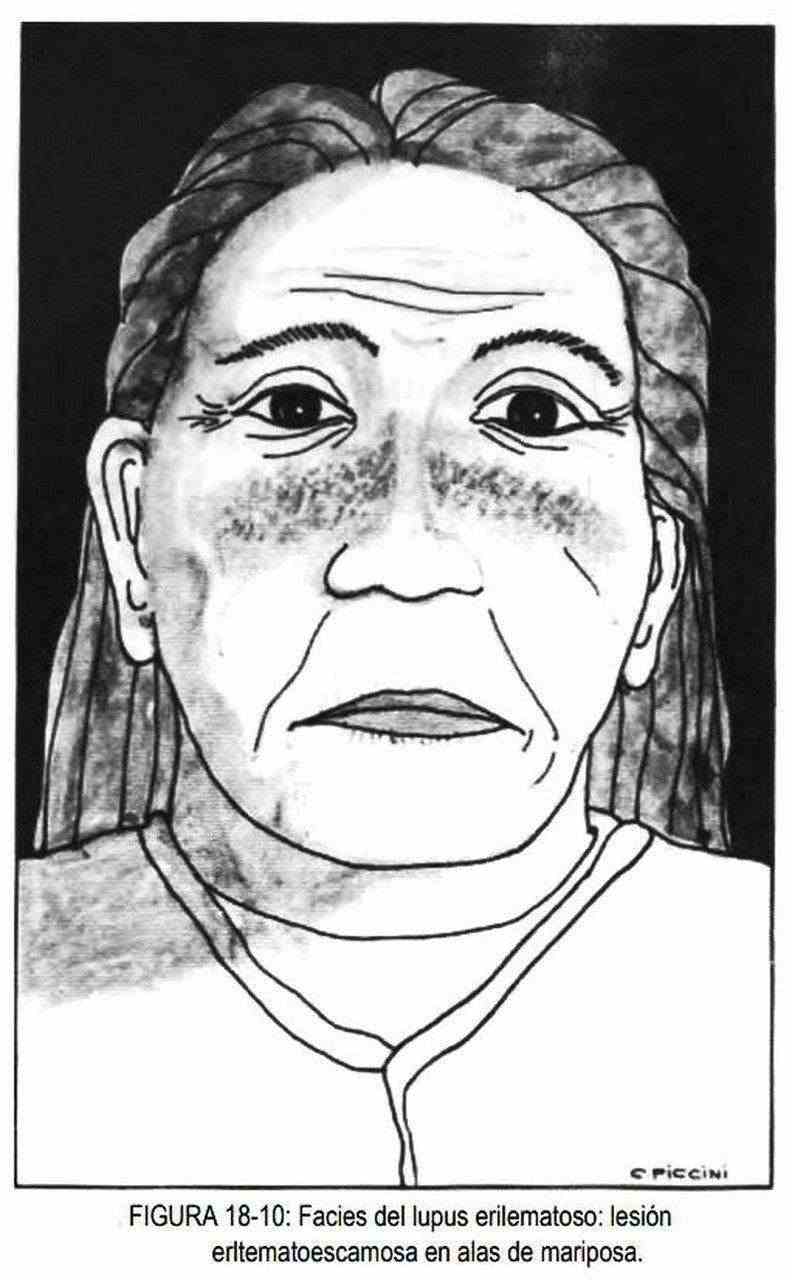 Lupus . In 40% of patients with systemic lupus erythematosus, sometimes as a reaction to sunlight, an erythematous-scaly lesion appears, with edema, at the level of the cheeks and nasal arch. This is called the butterfly wing or evening erythema (Figure 18-10).
Lupus . In 40% of patients with systemic lupus erythematosus, sometimes as a reaction to sunlight, an erythematous-scaly lesion appears, with edema, at the level of the cheeks and nasal arch. This is called the butterfly wing or evening erythema (Figure 18-10).
In the chronic phase of the disease, the skin atrophies and telangiectasias sometimes appear, and areas of baldness can also be observed. Discoid lupus (a chronic disease of the skin of the skull, face, and neck), with atrophy and scaling, hyperpigmented edges, and patchy hairy areas, rarely progresses to, but may be part of, systemic lupus erythematosus.
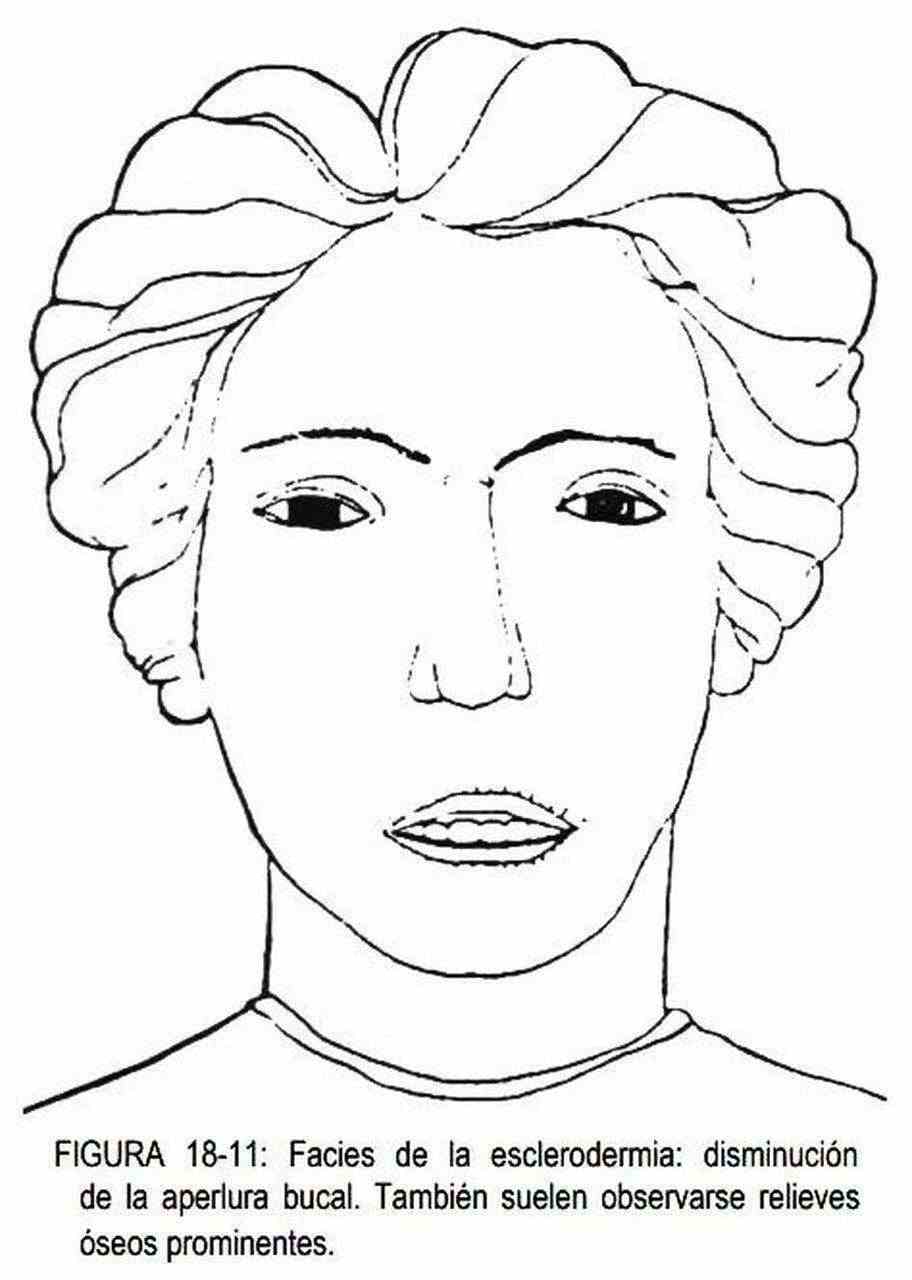 Scleroderma or bird facies . It is characterized by a decrease in the mouth opening, due to the atrophy and hardness of the skin (Figure 18-11), with prominent facial reliefs, mimicking the faces of some birds.
Scleroderma or bird facies . It is characterized by a decrease in the mouth opening, due to the atrophy and hardness of the skin (Figure 18-11), with prominent facial reliefs, mimicking the faces of some birds.
Heliotrope . It is the facies seen in dermatomyositis. The purple or helium color of the face, around the eyes and the upper jaw is striking.
Ehlers-Danlos syndrome . In this picture, the loose, deformable and elastic skin; Sometimes these patients can touch the nose with the tip of the tongue and also have hypermobility of the ligaments.
Marfanoid . The face is elongated, with ogival palate and visual difficulty due to lens subluxation, which is observed in 60% of cases. Surreptitious subluxation is diagnosed using the slit lamp. This facies is part of a hereditary syndrome.
Facies corresponding to hematological alterations
Thalassemia major . These patients are pale, usually blond children with high cheekbones and a broad forehead; they show a delay in the appearance of secondary sexual characteristics and are malnourished. Sometimes there may be signs of congestive heart failure.
Policitémica . One face is red eritrósica.
Leonina . It is seen in leukemic leaks and in Sézary syndrome, and also in nodular leprosy. It is characterized by infiltration of the skin of the cheeks, producing folds that give it a lion-like appearance. It can coexist with loss of eyebrow hair.
Manic . It is an exalted and hyperactive face, with a bright look.
From senile dementia . It combines signs of the Parkinson's facies (lack of movement and stiffness) with a disoriented, embarrassed and disconnected look from reality.
Miscellany
Of the mediastinal syndrome . It is a voluminous, edematous face, with protruding eyes; the veins are marked and engorged and edema is observed in the edema (shoulder and neck).
There may be cyanosis. It is produced by mediastinal obstruction due, in general, to a tumor located in this area.
Claude Bernard-Horner syndrome . In these patients, pseudoexophthalmos, eyelid, anhidrosis, and myiosis due to destruction of the stellate ganglion of the cervical chain are observed.
Of the Pourfour du Petit syndrome . The facies is characterized by exophthalmia and mydriasis due to irritation of the stellate ganglion of the sympathetic.
Dyslipidemia . It is an aged facies with graying hair and a senile arch at the corneal level. Of interest is the finding of a horizontal line in the upper part of the earlobe. It is found in patients with certain changes in blood lipids.
Of Hand-Schüller-Christian disease . Also called toad facies, it is characterized by unilateral or bilateral exophthalmos and drooping of the upper eyelids.
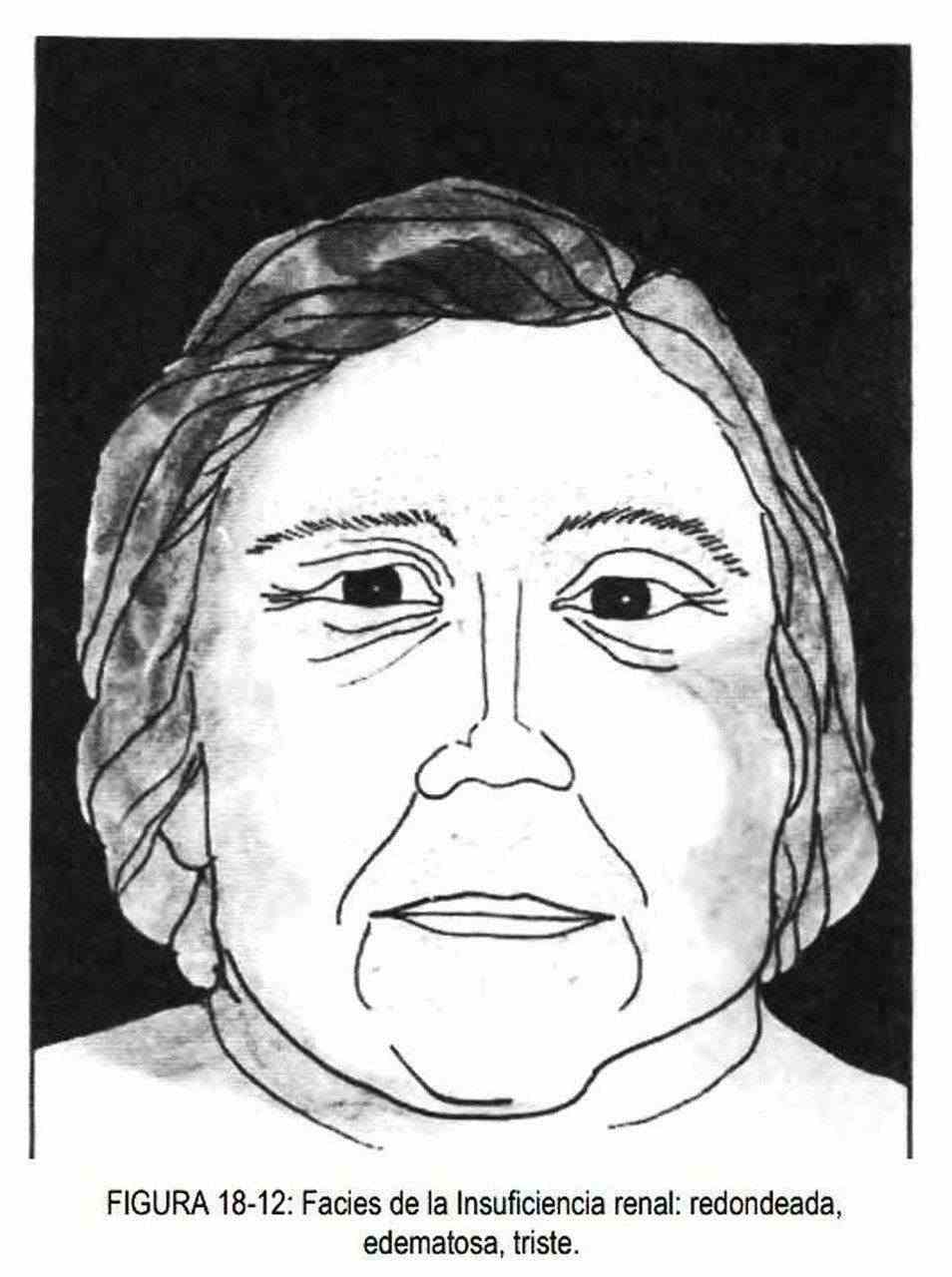 Renal failure (Figure 18-12). It is a puffy facies, with eyelid edema, pale or yellowish in color and with thinning hair. It differs from the hypothyroid facies because the patient presents anxiety and depression motivated by his illness.
Renal failure (Figure 18-12). It is a puffy facies, with eyelid edema, pale or yellowish in color and with thinning hair. It differs from the hypothyroid facies because the patient presents anxiety and depression motivated by his illness.
Mongolian . The face is rounded and small, with an exaggerated epicanthus (or third eyelid) that blurs the inner corner of the eye. The ears are protruding, in the shape of a loop, the lips are thick and the tongue is prominent.
It is characteristic of Down syndrome or trisomy 21, which presents with variable degrees of intellectual deficit.
Hippocratic . It is a pale face, with sharp features and purplish dark circles surrounding the eyes that are sunken. It is characteristic of dehydration and shock pictures.
Williams syndrome or goblin facies . It is characterized by the presence of prominent eyes, a turned up nose, and intellectual deficiency, although the gaze is bright. Supravalvular aortic stenosis is sometimes seen, and similar lesions are frequently present in the pulmonary artery. Sometimes it coexists with idiopathic hypercalcemia or hypervitaminosis D.
Hemihypertrophic . In this facies, one face is larger than the other. It is found in facial hemihypertrophy or Friedreich-Montgomery disease, which consists of excessive bone growth due to hemangioma, lymphangioma or neurofibroma.
Hemiatrophic . It is a facies opposite to the previous one with atrophy of the skin, muscles and bones, as occurs in Romberg's disease.
Alcoholic . It is characterized by a bright look, with conjunctival injection, telangiectasias and arachnid nevi. Occasionally, bilateral parotid hypertrophy is found.
Turner syndrome . Affected patients have a childlike face, with exaggerated development of the skin muscles of the neck; folds emerge from the lateral edges of the neck, giving it the appearance of a winged or sphinx-like facies. It is an intersex condition characterized by the presence of a single X chromosome, with an XO genotype and the absence of ovaries.
Myopathic . Forward salience of the upper lip is observed due to muscle atrophy and flaccidity (tapir snout). The mouth and eyes do not close properly, the laughter is carried out in a transverse direction and the execution of the whistle is impossible. The appearance is sad, with atrophy of the forehead and cheek (face in a mask).
Frog . It is a facies with exophthalmia, divergent strabismus and a great distance between both orbits. The skull is brachycephalic, with prominence of the vault in the form of a gabled roof. It is seen in craniofacial dysostosis or Crouzon's disease.
Werner's syndrome . It is characterized by the presence of gray hair, peeling of the forehead, ocular cataracts and atrophic skin. It is the facies of early aging.
From Hürler or Gargoilism . It is a grotesque face. The eyes are separated, with prominent supraorbital bridges, and the lips and teeth are small. These patients are broad in front and flat in profile. It is seen in mucopolysaccharidoses (deposits of mucopolysaccharides in tissues).
From sarcoidosis . It is characterized by a lateral protrusion of the eyeballs, due to the thickening of the lacrimal glands.
Gardner's syndrome . The facies is deformed due to the presence of frontal osteomas that constitute Gardner's syndrome. There are also multiple osteomas in other locations, epidermoid cysts and intestinal polyposis.
Of the beaten child . It is characterized by the presence of recent and long-standing bruises and abrasions, with dark circles and an expression of sadness.